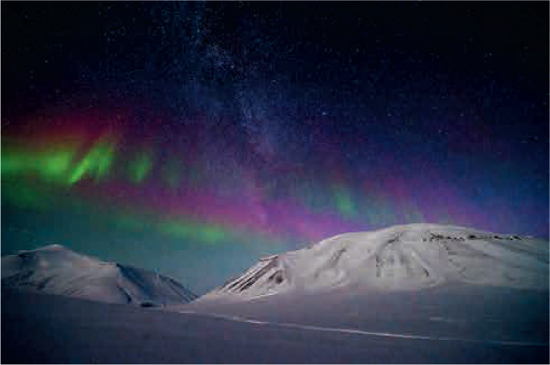
The numbers are overwhelming. The planet’s under unprecedented pressure. Too many forests cut down. Too many fish pulled from the sea. Too many species gone extinct. Earth’s being battered by humanity—and it’s coming from every direction. Greenhouse gases. Ocean acidification. Chemical pollution. It has all reached a point where our future is at risk. For the first time in human history, we may have pushed the planet too far.

Tebaran, a hunter in Borneo, fears a difficult future for indigenous people as logging operations destroy the rainforest. Deforestation also impacts biodiversity and global climate.
It’s happened so fast. In just two generations, humanity has overwhelmed Earth’s capacity to continue supporting our world in a stable way. We’ve gone from being a small world on a big planet to a big world on a small planet. Now Earth is responding with environmental shocks to the global economy. This is a great turning point. Our home is changing, and our future depends on what we do next.

Construction projects like this one in Hong Kong are part of a boom in economic growth and population. Two thirds of the cities needed by 2030 have not yet been built.
In a shrinking world, seemingly unrelated events can be links in the same chain of cause and effect. Nature, politics, and the economy are now interconnected. How a worker commutes in Stockholm affects the farmer in Ecuador. The web of life is fully connected, encompassing all of the planet’s ecosystems, and every link of the chain matters.

The aurora borealis plays across the sky over Svalbard, an Arctic archipelago. By reflecting sunlight back into space, the white surface of Arctic ice helps to cool the planet.
As Earth changes, we can expect surprises. The forces driving planetary change are complex and likely to create sudden, unexpected problems. In the past, we could assume that the big systems we relied on—from political to ecological—were stable and predictable. Increasingly today, and most certainly in the future, the only constant will be change. Surprise is the new normal.
Robert, a boy from Nyungwe, Rwanda, will grow up at a time when protection of ecosystems and human progress will prove equally important.
As many scientists have warned, nothing is more important than to avoid triggering disastrous tipping points in Earth’s fundamental processes. Fortunately, we now have enough knowledge and data to define planetary boundaries which, if transgressed, could lead to catastrophic problems. If we respect those boundaries, we can follow a safe path to unlimited opportunities into the future.

The rich biodiversity of the Selous Game Reserve in Tanzania is critical for landscape resilience, which contributes to the stability of the Earth system.
Ever since the industrial revolution, we’ve had this crazy idea that our actions are without consequences. That we can take nature or leave it. But as any farmer can tell you, that isn’t the case. It’s not a question of choosing jobs or the environment, because they depend on each other. That’s why we say we need a mind-shift to reconnect people with nature, societies with the biosphere, the human world with Earth.

Venom from snakes such as this Jameson’s mamba from Cameroon is helping researchers develop new drugs to treat heart disease in humans.
We take it for granted, the world that we love—and we’re destroying it so quickly. The light of dawn on the prairie. The silvery flash of fish in a stream. The cry of a hawk over a forest. Everybody has their own idea of the beautiful, and we’ll surely miss it when it’s gone. It’s time to fight for the remaining natural systems that support the beauty on Earth—not just for their sake but primarily to safeguard our prosperity.
Lianas twine around dipterocarp trees in Malaysia’s Danum Valley Conservation Area. Rainforests provide a vast number of ecosystem services for humanity.
We have the tools to do what’s required—the intelligence, creativity, and technological know-how. We can reverse the negative trends. We can feed nine billion people without destroying our forests. We can deliver power to our economies without burning fossil fuels. But the only way to achieve prosperity is through green growth. This is not a burden or sacrifice. It is an investment in future world prosperity. Business-as-usual is no longer an option.

Reconnecting societies with the biosphere is key to soaring opportunities for the future.
Humanity has an incredible ability to overcome even the most daunting of challenges. Once people understand the risks of continuing along the current path, they’ll search for creative—and profitable—alternatives. That’s how innovation works. The planetary boundaries will help. By defining thresholds and a maximum allowable use of resources, ecosystems, and the climate, we can trigger a new wave of sustainable technological inventions thanks to an abundance of ideas and solutions for human prosperity and planetary stability.

This ingenious storm-surge barrier was built to protect Rotterdam Harbor from flooding. By unleashing innovation within planetary boundaries, humanity can make abundant progress.
Let’s be realistic. Inspiring a mind-shift to sustainability could take a generation, and we should have started long ago. If we wait 30 more years, it will be too late. So we advocate a two-track approach: 1) tackle the most urgent problems right now, such as climate change, nitrogen and phosphorus overload, and loss of biodiversity, but also 2) do everything we can to reconnect with nature over the long term. Earth deserves nothing less. Our world depends on nothing less.
A field of rye evokes the ideal of abundant food for all. To achieve that with a booming global population will require a new revolution in agriculture.